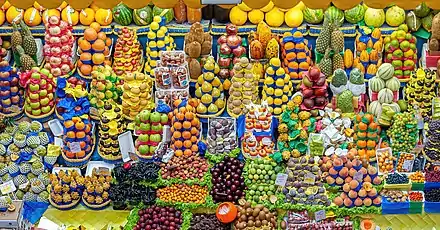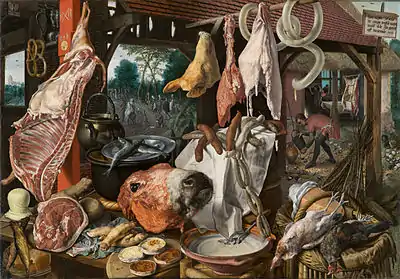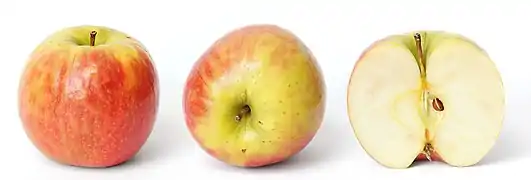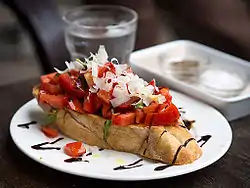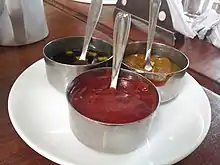F o o d
A portal dedicated to food and foodways
Introduction
.jpg.webp)
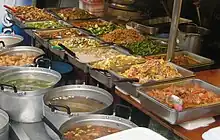
Food is any substance consumed by an organism for nutritional support. Food is usually of plant, animal, or fungal origin and contains essential nutrients such as carbohydrates, fats, proteins, vitamins, or minerals. The substance is ingested by an organism and assimilated by the organism's cells to provide energy, maintain life, or stimulate growth. Different species of animals have different feeding behaviours that satisfy the needs of their metabolisms and have evolved to fill a specific ecological niche within specific geographical contexts.
Omnivorous humans are highly adaptable and have adapted to obtain food in many different ecosystems. Humans generally use cooking to prepare food for consumption. The majority of the food energy required is supplied by the industrial food industry, which produces food through intensive agriculture and distributes it through complex food processing and food distribution systems. This system of conventional agriculture relies heavily on fossil fuels, which means that the food and agricultural systems are one of the major contributors to climate change, accounting for as much as 37% of total greenhouse gas emissions. (Full article...)
Cooking, also known as cookery or professionally as the culinary arts, is the art, science and craft of using heat to make food more palatable, digestible, nutritious, or safe. Cooking techniques and ingredients vary widely, from grilling food over an open fire to using electric stoves, to baking in various types of ovens, reflecting local conditions.
Preparing food with heat or fire is an activity unique to humans. Archeological evidence of cooking fires from at least 300,000 years ago exists, but some estimate that humans started cooking up to 2 million years ago.
The expansion of agriculture, commerce, trade, and transportation between civilizations in different regions offered cooks many new ingredients. New inventions and technologies, such as the invention of pottery for holding and boiling of water, expanded cooking techniques. Some modern cooks apply advanced scientific techniques to food preparation to further enhance the flavor of the dish served. (Full article...)
 Good article –
Good article –
An apple is a round, edible fruit produced by an apple tree (Malus spp., among them the domestic or orchard apple; Malus domestica). Apple trees are cultivated worldwide and are the most widely grown species in the genus Malus. The tree originated in Central Asia, where its wild ancestor, Malus sieversii, is still found. Apples have been grown for thousands of years in Asia and Europe and were introduced to North America by European colonists. Apples have religious and mythological significance in many cultures, including Norse, Greek, and European Christian tradition.
Apples grown from seed tend to be very different from those of their parents, and the resultant fruit frequently lacks desired characteristics. For commercial purposes, including botanical evaluation, apple cultivars are propagated by clonal grafting onto rootstocks. Apple trees grown without rootstocks tend to be larger and much slower to fruit after planting. Rootstocks are used to control the speed of growth and the size of the resulting tree, allowing for easier harvesting. (Full article...)
Selected article –

A croissant (French pronunciation: [kʁwasɑ̃] ⓘ) is a buttery, flaky, viennoiserie pastry inspired by the shape of the Austrian kipferl but using the French yeast-leavened laminated dough. Croissants are named for their historical crescent shape. The dough is layered with butter, rolled and folded several times in succession, then rolled into a thin sheet, in a technique called laminating. The process results in a layered, flaky texture, similar to a puff pastry.
Crescent-shaped breads have been made since the Renaissance, and crescent-shaped cakes possibly since antiquity. Kipferls have long been a staple of Austrian cuisine, and are often found in French bakeries and pâtisseries. The modern croissant was developed in the early 20th century when French bakers replaced the brioche dough of the kipferl with a yeast-leavened laminated dough. In the late 1970s, the development of factory-made, frozen, preformed but unbaked dough made them into a fast food that could be freshly baked by unskilled labor. The croissant bakery, notably the La Croissanterie chain, was a French response to American-style fast food, and as of 2008, 30–40% of the croissants sold in French bakeries and patisseries were baked from frozen dough. (Full article...)Selected cuisine -
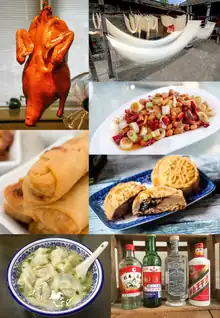
Chinese cuisine comprise cuisines originating from China, as well as from Chinese people originating from other parts of the world. Because of the Chinese diaspora and historical power of the country, Chinese cuisine has profoundly influenced many other cuisines in Asia and beyond, with modifications made to cater to local palates. Chinese food staples such as rice, soy sauce, noodles, tea, chili oil, and tofu, and utensils such as chopsticks and the wok, can now be found worldwide.
The world's earliest eating establishments recognizable as restaurants in the modern sense first emerged in Song dynasty China during the 11th and 12th centuries. Street food became an integral aspect of Chinese food culture during the Tang dynasty, and the street food culture of much of Southeast Asia was established by workers imported from China during the late 19th century. (Full article...)Selected ingredient –
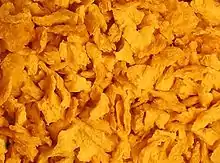
Textured or texturized vegetable protein (TVP), also known as textured soy protein (TSP), soy meat, or soya chunks is a defatted soy flour product, a by-product of extracting soybean oil. It is often used as a meat analogue or meat extender. It is quick to cook, with a protein content comparable to certain meats.
TVP may be produced from any protein-rich seed meal left over from vegetable oil production. Specifically, a wide range of pulse seeds besides soybean, including lentils, peas, and faba beans, may be used for TVP production. Peanut-based TVP is produced in China where peanut oil is a popular cooking oil. (Full article...)
Selected recipe –
Bruschetta (/bruːˈskɛtə/, /bruːˈʃɛtə/, Italian pronunciation: [bruˈsketta] ⓘ) is an antipasto (starter dish) from Italy consisting of grilled bread rubbed with garlic and topped with olive oil and salt. Variations may include toppings of tomato, vegetables, beans, cured meat, or cheese. In Italy, bruschetta is often prepared using a brustolina grill. (Full article...)
 Featured article –
Featured article –
Cabbage, comprising several cultivars of Brassica oleracea, is a leafy green, red (purple), or white (pale green) biennial plant grown as an annual vegetable crop for its dense-leaved heads. It is descended from the wild cabbage (B. oleracea var. oleracea), and belongs to the "cole crops" or brassicas, meaning it is closely related to broccoli and cauliflower (var. botrytis); Brussels sprouts (var. gemmifera); and Savoy cabbage (var. sabauda).
A cabbage generally weighs between 500 and 1,000 grams (1 and 2 lb). Smooth-leafed, firm-headed green cabbages are the most common, with smooth-leafed purple cabbages and crinkle-leafed savoy cabbages of both colours being rarer. Under conditions of long sunny days, such as those found at high northern latitudes in summer, cabbages can grow quite large. , the heaviest cabbage was 62.71 kilograms (138 lb 4 oz). Cabbage heads are generally picked during the first year of the plant's life cycle, but plants intended for seed are allowed to grow a second year and must be kept separate from other cole crops to prevent cross-pollination. Cabbage is prone to several nutrient deficiencies, as well as to multiple pests, and bacterial and fungal diseases. (Full article...)Selected image –
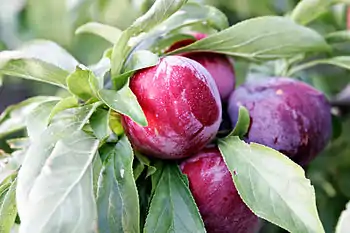
Selected biography –
B. April 24, 1914 – d. September 5, 2001
"Way back when I first started as a safety engineer, I took myself pretty seriously, and I found I was putting my audiences to sleep. So having lived all my life among the Cajuns of Louisiana, and having a good memory for the patois and the type of humor Cajuns go for, I started interspersing my talks on safety with Cajun humor."
Justin Wilson
Justin Elmer Wilson (April 24, 1914 – September 5, 2001) was a Southern American chef and humorist known for his brand of Cajun-inspired cuisine, humor and storytelling. (Full article...)
Did you know (auto-generated) –
- ... that the termite Odontotermes formosanus grows its own food?
- ... that the first cookbook edited by Maria Guarnaschelli helped introduce American cooks to Indian cuisine?
- ... that live huhu grubs have been served at the Hokitika Wildfoods Festival?
- ... that Cranksgiving has been described as "part bike ride, part food drive, part scavenger hunt"?
- ... that New Zealand editor and journalist Madeleine Chapman, known for fashion label exposés and snack food ranking lists, is a champion javelin thrower?
- ... that the Ni'isjoohl totem pole was once fed a diet of vacuum-packed food?
More did you know –
Related portals
Food topics
The following are topics relating to food
Categories
The following are categories relating to food.
![]()
Food list articles
- See also: Lists of foods and Category:Lists of drinks
The following are some Food list articles on Wikipedia:
- American cheeses
- Appellation d'Origine Contrôlée cheeses
- Apple cultivars
- Bacon dishes
- Bacon substitutes
- Basil cultivars
- Breads
- Breakfast beverages
- Breakfast cereals
- Breakfast foods
- British cheeses
- Cakes
- Candies
- Cheeses
- Cheese soups
- Christmas dishes (list)
- Cocktails
- Cookies
- Dishes using coconut milk
- Diets
- Doughnut varieties
- Egg dishes
- Fermented soy products
- Food additives
- Food additives (Codex Alimentarius)
- Foods named after people
- French cheeses
- French dishes
- Fried dough foods
- Fruits
- List of hamburgers
- Herbs and spices
- Hors d'oeuvre
- Indian dishes
- Indian snack foods
- Indonesian dishes
- Italian dishes
- Japanese snacks
- Japanese dishes
- Jewish dishes
- Kebabs
- Korean beverages
- Mango cultivars
- Moroccan dishes
- Pasta
- Pastries
- Philippine snack food
- Pies, tarts and flans
- Poppy seed pastries and dishes
- Potato dishes
- Puddings
- Raw fish dishes
- Rice dishes
- Rolled foods
- Sauces
- Seafood
- Seeds
- Sandwiches
- Snack foods
- Soft drinks by country
- Soul foods and dishes
- Soups
- Stews
- Street foods
- Tapas
- Turkish dishes
- Twice-baked foods
- Vegetable oils
- Vegetables
- Vodkas
Things you can do
 |
Here are some tasks awaiting attention:
|
Related WikiProjects
| Parent project: WikiProject Food and Drink | view |
| Child projects: | Task forces: (All inactive) |
|
|
| Related projects: | |
|
New articles
Rules | Match log | Results page (for watching) | Last updated: 2023-12-05 19:29 (UTC)
Note: The list display can now be customized by each user. See List display personalization for details.
- Cocina Hermanos Torres (edit | talk | history | links | watch | logs | tools) by Heroeswithmetaphors (talk · contribs · new pages (7)) started on 2023-12-05, score: 10
- Elsa Group (edit | talk | history | links | watch | logs | tools) by Mister Bucket (talk · contribs · new pages (2)) started on 2023-12-05, score: 10
- Igor Sapega (edit | talk | history | links | watch | logs | tools) by Shabukoy (talk · contribs · new pages (3)) started on 2023-12-05, score: 10
- Armageddon (pepper) (edit | talk | history | links | watch | logs | tools) by GenQuest (talk · contribs · new pages (2)) started on 2023-12-05, score: 10
- Bún kèn (edit | talk | history | links | watch | logs | tools) by J mareeswaran (talk · contribs · new pages (1)) started on 2023-12-04, score: 10
- Olipop (edit | talk | history | links | watch | logs | tools) by Panamitsu (talk · contribs · new pages (16)) started on 2023-11-24, score: 10
- Eric Gregory (edit | talk | history | links | watch | logs | tools) by Pyeongchang (talk · contribs · new pages (34)) started on 2023-12-03, score: 10
- Balticovo (edit | talk | history | links | watch | logs | tools) by PeckaA (talk · contribs · new pages (4)) started on 2023-12-03, score: 20
- Simple fruit (edit | talk | history | links | watch | logs | tools) by AHIOH (talk · contribs · new pages (3)) started on 2023-12-01, score: 10
- Lewis Orford (footballer) (edit | talk | history | links | watch | logs | tools) by Hildreth gazzard (talk · contribs · new pages (90)) started on 2023-11-30, score: 10
- Kirk Perron (edit | talk | history | links | watch | logs | tools) by WikiOriginal-9 (talk · contribs · new pages (371)) started on 2023-11-29, score: 10
- Nogger (edit | talk | history | links | watch | logs | tools) by Timtrent (talk · contribs · new pages (40)) started on 2023-11-29, score: 10
- Amur grayling (edit | talk | history | links | watch | logs | tools) by HolyCrocsEmperor (talk · contribs · new pages (11)) started on 2023-11-28, score: 10
- Mastava (edit | talk | history | links | watch | logs | tools) by JakhongirOdilov (talk · contribs · new pages (27)) started on 2023-11-27, score: 10
- Dak-hanmari (edit | talk | history | links | watch | logs | tools) by Gray eyes (talk · contribs · new pages (67)) started on 2023-11-27, score: 10
- Black water (drink) (edit | talk | history | links | watch | logs | tools) by Mbdfar (talk · contribs · new pages (6)) started on 2023-11-27, score: 20
- Kaki furai (edit | talk | history | links | watch | logs | tools) by Dying (talk · contribs · new pages (4)) started on 2023-11-26, score: 20
- Vilvi group (edit | talk | history | links | watch | logs | tools) by Radom1967 (talk · contribs · new pages (38)) started on 2023-11-25, score: 20
- Rokiškio sūris (edit | talk | history | links | watch | logs | tools) by Radom1967 (talk · contribs · new pages (38)) started on 2023-11-25, score: 20
- Agriculture, Nutrition and Health Academy (edit | talk | history | links | watch | logs | tools) by Tumbuka Arch (talk · contribs · new pages (48)) started on 2023-11-25, score: 10
- Žemaitijos pienas (edit | talk | history | links | watch | logs | tools) by Radom1967 (talk · contribs · new pages (38)) started on 2023-11-25, score: 20
- Les Wotton (edit | talk | history | links | watch | logs | tools) by Pyeongchang (talk · contribs · new pages (34)) started on 2023-11-25, score: 10
- Watergate cake (edit | talk | history | links | watch | logs | tools) by Bridget (talk · contribs · new pages (5)) started on 2023-11-24, score: 20
- Cenil (edit | talk | history | links | watch | logs | tools) by Gunkarta (talk · contribs · new pages (1)) started on 2023-11-23, score: 20
- Coffee stamp (edit | talk | history | links | watch | logs | tools) by Freetrashbox (talk · contribs · new pages (2)) started on 2023-11-23, score: 10
- La Nevera Roja (edit | talk | history | links | watch | logs | tools) by Miskito89 (talk · contribs · new pages (7)) started on 2023-11-23, score: 20
- Bharath Coffee House (edit | talk | history | links | watch | logs | tools) by Thilsebatti (talk · contribs · new pages (23)) started on 2023-11-22, score: 10
- Sheil Shukla (edit | talk | history | links | watch | logs | tools) by Classicfilms (talk · contribs · new pages (2)) started on 2023-11-21, score: 10
- Hannah Che (edit | talk | history | links | watch | logs | tools) by Classicfilms (talk · contribs · new pages (2)) started on 2023-11-21, score: 20
Associated Wikimedia
The following Wikimedia Foundation sister projects provide more on this subject:
-
 Commons
Commons
Free media repository -
 Wikibooks
Wikibooks
Free textbooks and manuals -
 Wikidata
Wikidata
Free knowledge base -
 Wikinews
Wikinews
Free-content news -
 Wikiquote
Wikiquote
Collection of quotations -
 Wikisource
Wikisource
Free-content library -
 Wikiversity
Wikiversity
Free learning tools -
 Wiktionary
Wiktionary
Dictionary and thesaurus
Sources
More portals
-
 List of all portalsList of all portals
List of all portalsList of all portals -
 The arts portal
The arts portal -
 Biography portal
Biography portal -
 Current events portal
Current events portal -
 Geography portal
Geography portal -
 History portal
History portal -
 Mathematics portal
Mathematics portal -
 Science portal
Science portal -
 Society portal
Society portal -
 Technology portal
Technology portal -
 Random portalRandom portal
Random portalRandom portal -
 WikiProject PortalsWikiProject Portals
WikiProject PortalsWikiProject Portals


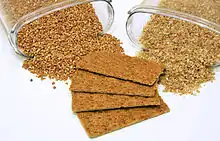
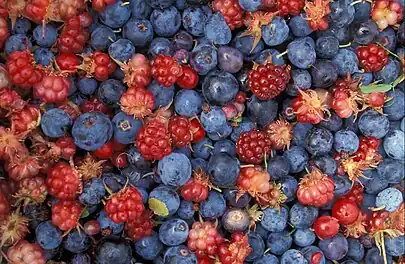

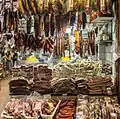






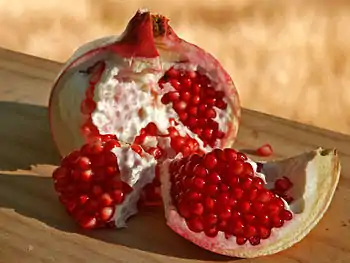


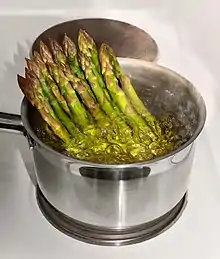
.jpg.webp)
